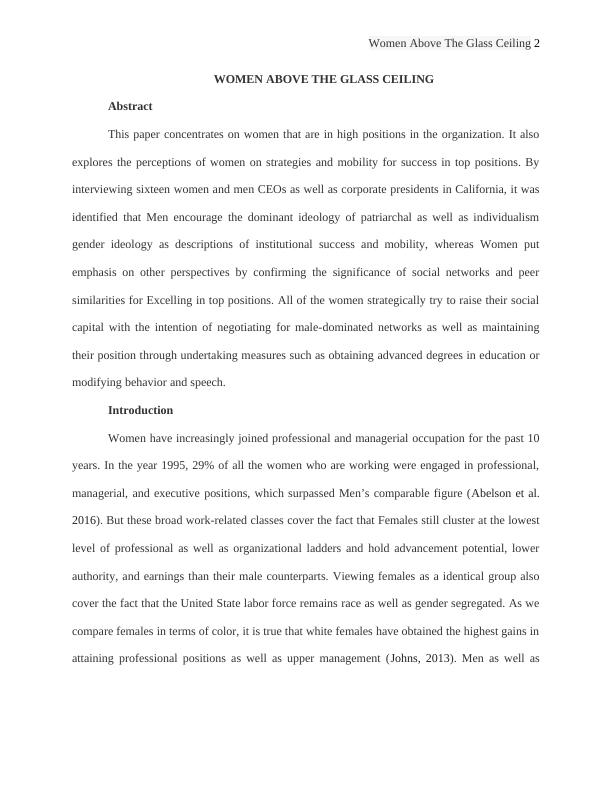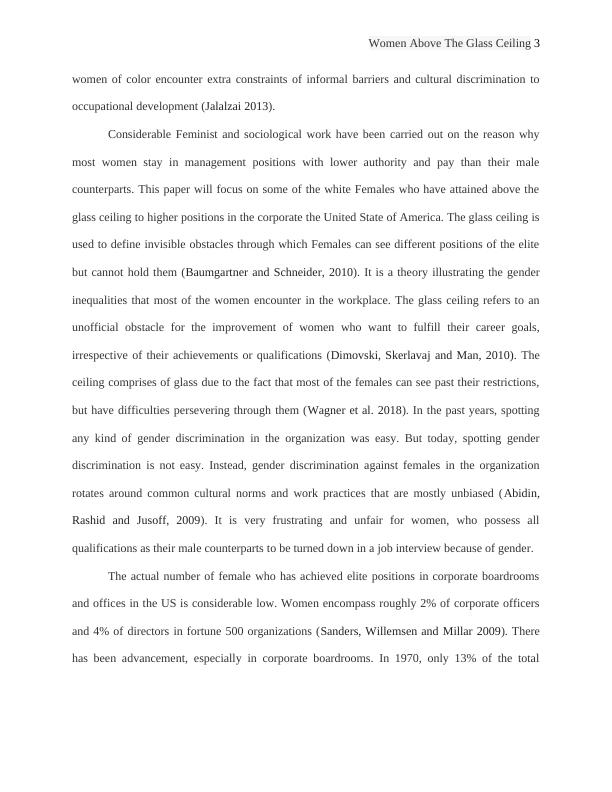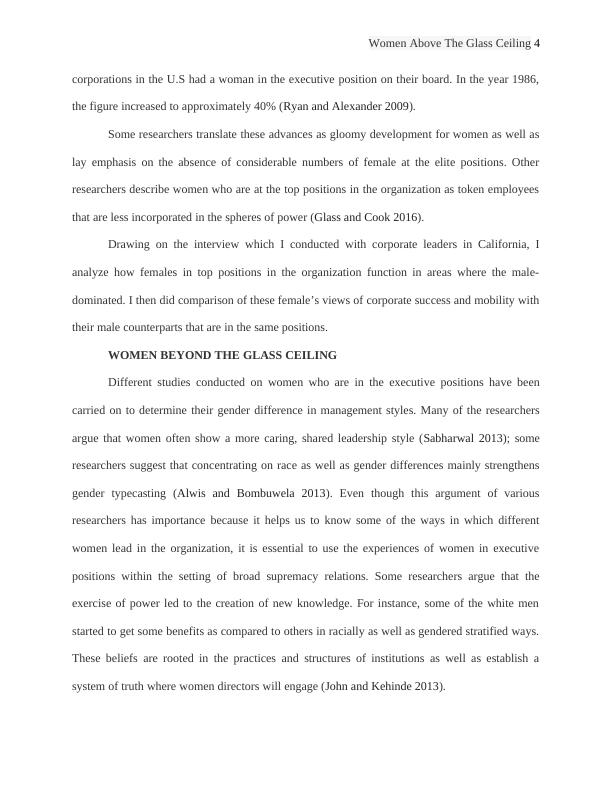Women Above The Glass Ceiling
18 Pages5363 Words59 Views
Added on 2023-01-20
About This Document
This paper explores the perceptions of women on strategies and mobility for success in top positions. It analyzes how women strategically raise their social capital to excel in male-dominated networks.
Women Above The Glass Ceiling
Added on 2023-01-20
ShareRelated Documents
Women Above The Glass Ceiling 1
WOMEN ABOVE THE GLASS CEILING
By (Student’s Name)
Professor’s Name
College
Course
Date
WOMEN ABOVE THE GLASS CEILING
By (Student’s Name)
Professor’s Name
College
Course
Date

Women Above The Glass Ceiling 2
WOMEN ABOVE THE GLASS CEILING
Abstract
This paper concentrates on women that are in high positions in the organization. It also
explores the perceptions of women on strategies and mobility for success in top positions. By
interviewing sixteen women and men CEOs as well as corporate presidents in California, it was
identified that Men encourage the dominant ideology of patriarchal as well as individualism
gender ideology as descriptions of institutional success and mobility, whereas Women put
emphasis on other perspectives by confirming the significance of social networks and peer
similarities for Excelling in top positions. All of the women strategically try to raise their social
capital with the intention of negotiating for male-dominated networks as well as maintaining
their position through undertaking measures such as obtaining advanced degrees in education or
modifying behavior and speech.
Introduction
Women have increasingly joined professional and managerial occupation for the past 10
years. In the year 1995, 29% of all the women who are working were engaged in professional,
managerial, and executive positions, which surpassed Men’s comparable figure (Abelson et al.
2016). But these broad work-related classes cover the fact that Females still cluster at the lowest
level of professional as well as organizational ladders and hold advancement potential, lower
authority, and earnings than their male counterparts. Viewing females as a identical group also
cover the fact that the United State labor force remains race as well as gender segregated. As we
compare females in terms of color, it is true that white females have obtained the highest gains in
attaining professional positions as well as upper management (Johns, 2013). Men as well as
WOMEN ABOVE THE GLASS CEILING
Abstract
This paper concentrates on women that are in high positions in the organization. It also
explores the perceptions of women on strategies and mobility for success in top positions. By
interviewing sixteen women and men CEOs as well as corporate presidents in California, it was
identified that Men encourage the dominant ideology of patriarchal as well as individualism
gender ideology as descriptions of institutional success and mobility, whereas Women put
emphasis on other perspectives by confirming the significance of social networks and peer
similarities for Excelling in top positions. All of the women strategically try to raise their social
capital with the intention of negotiating for male-dominated networks as well as maintaining
their position through undertaking measures such as obtaining advanced degrees in education or
modifying behavior and speech.
Introduction
Women have increasingly joined professional and managerial occupation for the past 10
years. In the year 1995, 29% of all the women who are working were engaged in professional,
managerial, and executive positions, which surpassed Men’s comparable figure (Abelson et al.
2016). But these broad work-related classes cover the fact that Females still cluster at the lowest
level of professional as well as organizational ladders and hold advancement potential, lower
authority, and earnings than their male counterparts. Viewing females as a identical group also
cover the fact that the United State labor force remains race as well as gender segregated. As we
compare females in terms of color, it is true that white females have obtained the highest gains in
attaining professional positions as well as upper management (Johns, 2013). Men as well as

Women Above The Glass Ceiling 3
women of color encounter extra constraints of informal barriers and cultural discrimination to
occupational development (Jalalzai 2013).
Considerable Feminist and sociological work have been carried out on the reason why
most women stay in management positions with lower authority and pay than their male
counterparts. This paper will focus on some of the white Females who have attained above the
glass ceiling to higher positions in the corporate the United State of America. The glass ceiling is
used to define invisible obstacles through which Females can see different positions of the elite
but cannot hold them (Baumgartner and Schneider, 2010). It is a theory illustrating the gender
inequalities that most of the women encounter in the workplace. The glass ceiling refers to an
unofficial obstacle for the improvement of women who want to fulfill their career goals,
irrespective of their achievements or qualifications (Dimovski, Skerlavaj and Man, 2010). The
ceiling comprises of glass due to the fact that most of the females can see past their restrictions,
but have difficulties persevering through them (Wagner et al. 2018). In the past years, spotting
any kind of gender discrimination in the organization was easy. But today, spotting gender
discrimination is not easy. Instead, gender discrimination against females in the organization
rotates around common cultural norms and work practices that are mostly unbiased (Abidin,
Rashid and Jusoff, 2009). It is very frustrating and unfair for women, who possess all
qualifications as their male counterparts to be turned down in a job interview because of gender.
The actual number of female who has achieved elite positions in corporate boardrooms
and offices in the US is considerable low. Women encompass roughly 2% of corporate officers
and 4% of directors in fortune 500 organizations (Sanders, Willemsen and Millar 2009). There
has been advancement, especially in corporate boardrooms. In 1970, only 13% of the total
women of color encounter extra constraints of informal barriers and cultural discrimination to
occupational development (Jalalzai 2013).
Considerable Feminist and sociological work have been carried out on the reason why
most women stay in management positions with lower authority and pay than their male
counterparts. This paper will focus on some of the white Females who have attained above the
glass ceiling to higher positions in the corporate the United State of America. The glass ceiling is
used to define invisible obstacles through which Females can see different positions of the elite
but cannot hold them (Baumgartner and Schneider, 2010). It is a theory illustrating the gender
inequalities that most of the women encounter in the workplace. The glass ceiling refers to an
unofficial obstacle for the improvement of women who want to fulfill their career goals,
irrespective of their achievements or qualifications (Dimovski, Skerlavaj and Man, 2010). The
ceiling comprises of glass due to the fact that most of the females can see past their restrictions,
but have difficulties persevering through them (Wagner et al. 2018). In the past years, spotting
any kind of gender discrimination in the organization was easy. But today, spotting gender
discrimination is not easy. Instead, gender discrimination against females in the organization
rotates around common cultural norms and work practices that are mostly unbiased (Abidin,
Rashid and Jusoff, 2009). It is very frustrating and unfair for women, who possess all
qualifications as their male counterparts to be turned down in a job interview because of gender.
The actual number of female who has achieved elite positions in corporate boardrooms
and offices in the US is considerable low. Women encompass roughly 2% of corporate officers
and 4% of directors in fortune 500 organizations (Sanders, Willemsen and Millar 2009). There
has been advancement, especially in corporate boardrooms. In 1970, only 13% of the total

Women Above The Glass Ceiling 4
corporations in the U.S had a woman in the executive position on their board. In the year 1986,
the figure increased to approximately 40% (Ryan and Alexander 2009).
Some researchers translate these advances as gloomy development for women as well as
lay emphasis on the absence of considerable numbers of female at the elite positions. Other
researchers describe women who are at the top positions in the organization as token employees
that are less incorporated in the spheres of power (Glass and Cook 2016).
Drawing on the interview which I conducted with corporate leaders in California, I
analyze how females in top positions in the organization function in areas where the male-
dominated. I then did comparison of these female’s views of corporate success and mobility with
their male counterparts that are in the same positions.
WOMEN BEYOND THE GLASS CEILING
Different studies conducted on women who are in the executive positions have been
carried on to determine their gender difference in management styles. Many of the researchers
argue that women often show a more caring, shared leadership style (Sabharwal 2013); some
researchers suggest that concentrating on race as well as gender differences mainly strengthens
gender typecasting (Alwis and Bombuwela 2013). Even though this argument of various
researchers has importance because it helps us to know some of the ways in which different
women lead in the organization, it is essential to use the experiences of women in executive
positions within the setting of broad supremacy relations. Some researchers argue that the
exercise of power led to the creation of new knowledge. For instance, some of the white men
started to get some benefits as compared to others in racially as well as gendered stratified ways.
These beliefs are rooted in the practices and structures of institutions as well as establish a
system of truth where women directors will engage (John and Kehinde 2013).
corporations in the U.S had a woman in the executive position on their board. In the year 1986,
the figure increased to approximately 40% (Ryan and Alexander 2009).
Some researchers translate these advances as gloomy development for women as well as
lay emphasis on the absence of considerable numbers of female at the elite positions. Other
researchers describe women who are at the top positions in the organization as token employees
that are less incorporated in the spheres of power (Glass and Cook 2016).
Drawing on the interview which I conducted with corporate leaders in California, I
analyze how females in top positions in the organization function in areas where the male-
dominated. I then did comparison of these female’s views of corporate success and mobility with
their male counterparts that are in the same positions.
WOMEN BEYOND THE GLASS CEILING
Different studies conducted on women who are in the executive positions have been
carried on to determine their gender difference in management styles. Many of the researchers
argue that women often show a more caring, shared leadership style (Sabharwal 2013); some
researchers suggest that concentrating on race as well as gender differences mainly strengthens
gender typecasting (Alwis and Bombuwela 2013). Even though this argument of various
researchers has importance because it helps us to know some of the ways in which different
women lead in the organization, it is essential to use the experiences of women in executive
positions within the setting of broad supremacy relations. Some researchers argue that the
exercise of power led to the creation of new knowledge. For instance, some of the white men
started to get some benefits as compared to others in racially as well as gendered stratified ways.
These beliefs are rooted in the practices and structures of institutions as well as establish a
system of truth where women directors will engage (John and Kehinde 2013).

End of preview
Want to access all the pages? Upload your documents or become a member.
Related Documents
Qualities of Female Managers in the Middle-East and Saudi Government's Rolelg...
|21
|3841
|23
Gender Discrimination in Workplace in UKlg...
|9
|2827
|140
Gender and Intersectionalitylg...
|7
|2104
|164
Management 2022 Case Studylg...
|5
|1240
|19
Encyclopedia of Critical Psychologylg...
|8
|2394
|11
Women and Workplace Discrimination in Australian Organizationslg...
|17
|4508
|90
